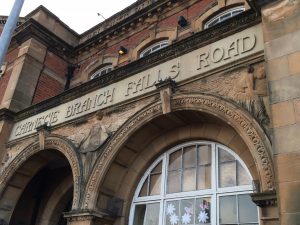
It’s that time of year again, beloved patrons, when your favorite Blogger heads off to get some research done…and I know we’ve been to Belfast before, but I’m working on the same Dissertation, so we are heading back to the same city.
I’ve tried to make thing a bit interesting for you, dear readers, by going on some new adventures, however. This time around, I trekked out to Falls Road, in West Belfast, to visit the only operational Carnegie Library in Belfast.
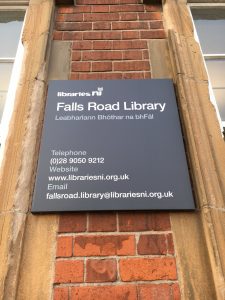 Originally, the area that became the Falls Road was a petty kindgom known in Irish as Túath na bhFál, or Territory of the Enclosures. It was incorporated into Belfast by the British government in the 19th century, and today, the Falls Road is very much a working-class area of Belfast. Since the late 1960’s, has been a bedrock of Socialist and Irish Nationalist politics. The worldwide Civil Rights movement united Northern Irish Catholics into a political group that rallied for better housing and voting rights (it’s a complicated system, but essentially, business owners had more say in elections, and the economy was structured to favor Protestant business owners). This prompted Protestants in power to fear a Catholic uprising that would unite Northern Ireland and the Republic of Ireland, and resulting in a backlash against protestors that, to many, seemed very excessive. The result was what has become known as The Troubles in Northern Ireland, and, in many ways, the Falls Road was at the center of the conflict.
Originally, the area that became the Falls Road was a petty kindgom known in Irish as Túath na bhFál, or Territory of the Enclosures. It was incorporated into Belfast by the British government in the 19th century, and today, the Falls Road is very much a working-class area of Belfast. Since the late 1960’s, has been a bedrock of Socialist and Irish Nationalist politics. The worldwide Civil Rights movement united Northern Irish Catholics into a political group that rallied for better housing and voting rights (it’s a complicated system, but essentially, business owners had more say in elections, and the economy was structured to favor Protestant business owners). This prompted Protestants in power to fear a Catholic uprising that would unite Northern Ireland and the Republic of Ireland, and resulting in a backlash against protestors that, to many, seemed very excessive. The result was what has become known as The Troubles in Northern Ireland, and, in many ways, the Falls Road was at the center of the conflict.
In 1970, the British Government imposed what was called “The Falls Curfew”, during which some 3,000 British troops sealed off the Falls Road neighborhood–home to about 10,000 people–with arms and tear gas. For those who were not already die-hard Republicans (who believed in a united Ireland), this was the final straw. Even today, the area is marked out by garlands of the Irish national flag, and a huge number of murals that demonstrate allegiance to political prisoners around the world, as well as those who are victims of violence, like this one that commemorated the shooting in Orlando, Florida in June.
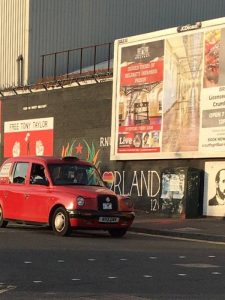
One of the most prominent and famous murals is the one dedicated to Bobby Sands. In 1981, Bobby Sands, who grew up in the Falls Road area, was a member of the Provisional Irish Republican Army, and became the leader of IRA who were being held in the Long Kesh Prison at the age of 26. Sands was in his sixth year of a fourteen year sentence when he led a hunger strike that was intended to force the British Government to give IRA prisoners special status (effectively recognizing them as prisoners of war, rather than common criminals). He died 66 days later, the first of ten men to die on the strike. The Hunger Strike itself garnered worldwide attention, radicalized Irish politics, and was instrumental in getting Sinn Fein, until then a fringe political party, into mainstream politics. This is the 35 anniversary of those hunger strikes, and, in additional to being commemorated all around the Falls Road, a new documentary has been released about Sands himself, and the movement he led, which is getting a huge amount of attention, praise, and criticism, particularly from families of IRA violence.
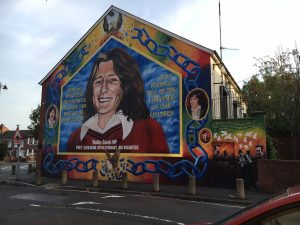
The Falls Road Library was opened in 1908, and was the first of three libraries built in Belfast with money from the Carnegie Foundation, which also built the Melrose Library (as well as a number of others that are not on the NOBLE network). Carnegie Libraries were all built with money donated by Scottish-American businessman Andrew Carnegie, who didn’t always treat his workers terribly well (see the 1892 Homstead Strike, for example), but who built over 3,000 libraries around the world. Like George Peabody, Carnegie wanted people to have access to libraries, and beautiful libraries, at that. His natural-born curiosity made him an active learner all his life, and he wanted to share that sense of intellectual adventure around the world. However, these buildings aren’t always easy to keep-up, or to run, so the number of Carnegie Libraries is falling away (many are being turned into larger municipal buildings or private residences, and many more have been demolished or have burned down and never replaced). So the chance to visit one–and a thriving one, at that–is always a treat.
On the outside, The Falls Road Library is a stunning turn-of-the-century building, as you can see from the photo at the top of this post. On the inside, though, it’s been beautifully renovated, with lots of room for books, meetings, and programs (you can check out their website here, if you like). I must also comment on their super-comfy chairs, from which I took this not-very-good picture of the ground floor reading room:
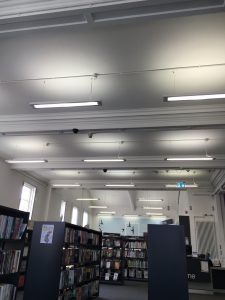
If you want to learn more about the Falls Road, its legacy, and the people who call it home, here are a few books you can check out today!
 Shattering Silence: Begoña Aretxaga spent a year living with the community in the Falls Road during the height of The Troubles in the 1970’s, and her descriptions of living conditions and activism there is extraordinarily powerful. The premise of her book, however, is how women, specifically, gained power and political agency through their activism, in a way that men couldn’t. It focuses on motherhood and women’s health, on public protests and education, and is as helpful a book on gender studies as it is on modern Irish history. You’ll have to order this book from the Boston Public Library, but, believe me, it is completely and totally worth the wait.
Shattering Silence: Begoña Aretxaga spent a year living with the community in the Falls Road during the height of The Troubles in the 1970’s, and her descriptions of living conditions and activism there is extraordinarily powerful. The premise of her book, however, is how women, specifically, gained power and political agency through their activism, in a way that men couldn’t. It focuses on motherhood and women’s health, on public protests and education, and is as helpful a book on gender studies as it is on modern Irish history. You’ll have to order this book from the Boston Public Library, but, believe me, it is completely and totally worth the wait.
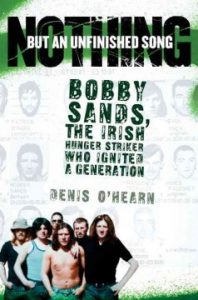 Nothing But an Unfinished Song : Bobby Sands, the Irish Hunger Striker who Ignited a Generation: Originally released to mark the twenty-fifth anniversary of the 1981 hunger strikes, Denis O’Hare’s book not only deals with Bobby Sands himself, but of the movement he helped lead within Long Kesh prison, a deeply Socialist movement that was as much cultural as it was political, and the world in which he operated–a world of deep economic deprivations, particularly in Northern Ireland, and a time of enormous change within the Irish Republican movement. He also deals with the worldwide implications of this strike, from the speeches made in Peru to the hunger strike that Nelson Mandela held in support. Without shying away from the more idealistic and unsavory aspects of Sands and the movement as a whole, O’Hare’s book is a well-rounded and very engaging piece of work that will really help those looking for a good introduction, or follow-up, to this crucial moment in Northern Irish history.
Nothing But an Unfinished Song : Bobby Sands, the Irish Hunger Striker who Ignited a Generation: Originally released to mark the twenty-fifth anniversary of the 1981 hunger strikes, Denis O’Hare’s book not only deals with Bobby Sands himself, but of the movement he helped lead within Long Kesh prison, a deeply Socialist movement that was as much cultural as it was political, and the world in which he operated–a world of deep economic deprivations, particularly in Northern Ireland, and a time of enormous change within the Irish Republican movement. He also deals with the worldwide implications of this strike, from the speeches made in Peru to the hunger strike that Nelson Mandela held in support. Without shying away from the more idealistic and unsavory aspects of Sands and the movement as a whole, O’Hare’s book is a well-rounded and very engaging piece of work that will really help those looking for a good introduction, or follow-up, to this crucial moment in Northern Irish history.
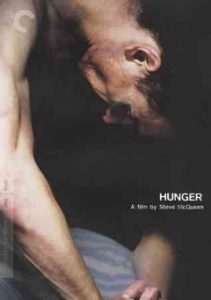 Hunger: Alexander McQueen’s first film is enormously powerful for a number of reasons–many of the actors in the cast are Northern Irish or Irish natives, whose own memories of The Troubles and the 1981 Hunger Strikes influenced their performances; Michael Fassbender’s performance as Bobby Sands is a truly remarkable example of dedication (and the truly terrible nature of a hunger strike); perhaps, most of all, McQueen was very dedicated to showing how conditions for prisoners and prison workers alike was a unique form of hell, making this a remarkably balanced–though not easy to watch–film.
Hunger: Alexander McQueen’s first film is enormously powerful for a number of reasons–many of the actors in the cast are Northern Irish or Irish natives, whose own memories of The Troubles and the 1981 Hunger Strikes influenced their performances; Michael Fassbender’s performance as Bobby Sands is a truly remarkable example of dedication (and the truly terrible nature of a hunger strike); perhaps, most of all, McQueen was very dedicated to showing how conditions for prisoners and prison workers alike was a unique form of hell, making this a remarkably balanced–though not easy to watch–film.
Carnegie Libraries; Their History and Impact on American Public Library Development: Just like the title says…here is a history of America’s Carnegie Libraries, and the way in which they changed our national Public Library system.

Thank you for bringing us on your journey ! It is most wonderful of you to share your adventures. I hope to read more.
Godspeed.